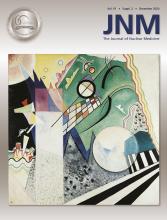In 2005, Nestle et al. (1) published their seminal paper comparing different methods to delineate radiotherapy target volume from 18F-FDG PET in non–small cell lung cancer (NSCLC). They compared 4 different methods for primary delineation of gross-tumor target volume: a visual method, 2 fixed-threshold methods, and 1 adaptive-threshold method. They found that the corresponding gross-tumor target volumes differ considerably and that the more complex adaptive-threshold algorithm should be further evaluated. From these early steps of evaluation, the randomized PET-Plan multicenter trial was developed to compare locoregional progression after definitive radiochemotherapy using 18F-FDG PET–based planning target volumes or conventional planning target volumes in locally advanced NSCLC (2). The PET-based gross tumor target volumes were delineated with a semiautomatic adaptive-threshold algorithm and expanded to clinical target volumes, including the anatomic extent of involved lymph nodes, and to a planning target volume that also considered set-up errors. The conventional target volumes contained the PET-based target volumes but included parts of PET-negative tumor-associated atelectases, as well as elective mediastinal nodal volumes known to be at higher risk from surgical series. Slightly higher total radiation doses were given in the PET-based arm respecting predefined normal-tissue tolerances. Noninferiority of the PET-based planning target volumes could be confirmed in a per-protocol analysis. The PET-Plan trial took more than 10 years from the initial methodologic studies in 2005 until publication in 2020, indicating the prolonged innovation cycles needed to establish new methods with high-level evidence in radiation oncology (2). The PET-Plan and other trials showed that only about 20% of locoregional recurrences were outside the PET-based target volume and that the relapses at the initial PET-positive macroscopic tumor and at distant metastases remain the dominant risks after the radiochemotherapy regimens used. Therefore, the sensitivity of 18F-FDG PET/CT turned out to be good enough for target volume delineation of locally advanced NSCLC given the concurrent risks of in-field locoregional relapse and distant metastases. Subclinical regional disease not detected by PET/CT might not be of critical relevance for these treatment regimes.
In delineating target volumes, it is of special importance that tumor motion be separated from anatomic tumor spread, as motion during radiation therapy can be selectively reduced by gating or tracking or by irradiation during voluntary breath-hold. Important new techniques emerge in clinical routine, such as elastic motion deblurring algorithms for calculation of motion-corrected images with improved lesion contrast. In addition, advanced automatic segmentation algorithms on PET/CT are under evaluation using deep-learning methods.
18F-FDG PET/CT has additional great benefits for radiotherapy planning in stage III NSCLC. The prognosis of patients with locally advanced NSCLC was improved during the first decade of this century, mainly not because of development of more effective treatments but because of stage migration due to the increased sensitivity of 18F-FDG PET/CT for detection of distant metastases (3).
Decreases in SUV in the primary tumor during induction chemotherapy could be validated as an important prognostic factor for survival and progression-free survival after radiochemotherapy in NSCLC (4). Dose escalation strategies on tumor with residual metabolic activity in a midtreatment 18F-FDG PET/CT study are under investigation for patients with locally advanced NSCLC, as in the RTOG1106/ACRIN 6697 trial, but mature data are lacking (5).
In conclusion, the work of Nestle et al. pioneered 18F-FDG PET–based target volume segmentation in radiotherapy of locally advanced NSCLC, allowing omission of elective nodal irradiation. Improving the accuracy of the target volumes in radiotherapy by integrating the latest technical achievements and thorough validation remains a central task in radiotherapy.
DISCLOSURE
No potential conflict of interest relevant to this article was reported.
- © 2020 by the Society of Nuclear Medicine and Molecular Imaging.
REFERENCES
- Received for publication June 15, 2020.
- Accepted for publication August 27, 2020.







